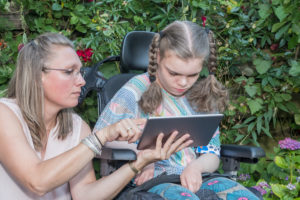by Emma Franke, CTC Volunteer

Therapists at Children’s Therapy Center have reported that virtual appointments are helping parents and caregivers see strong results at home.
Occupational Therapist Allison Payton, who works with children ages 3 and older in our center-based program, had no idea how much things would change when she accepted a new job at the Children’s Therapy Center right before Washington State went into lockdown. “I had just two weeks at the clinic before everything closed, and since then we’ve moved to completely virtual appointments,” says Payton.
Families and therapists have been working together to find in-home alternatives to some of the usual activities that take place in the clinic. At-home items like laundry baskets, cooking utensils, books and pillows have all become useful tools for teaching new motor skills.
Megan Robert, a center-based physical therapist with Children’s Therapy Center, recently had a family set up an in-home obstacle course to help their child work on walking and motor skills. “This family was trying to find household items. It was all the kids’ favorite part,” says Robert.
The huge benefit that has come from tele-intervention, for both Payton and Robert, is the increase in confidence that parents are gaining from being the primary person at hand to help their children work through new skills. “Now more than ever, the therapist and the family or caregivers are a team,” says Payton. “It can be really empowering for a lot of caregivers to be our hands and guide and lead.”
In order to help parents implement new skills with their kids, Robert has been using a doll to demonstrate hand placement and supplementing with videos to clarify what caregivers need to do. “Everybody’s learning styles have had to adapt,” says Robert. “Sometimes we’ll tell parents to do it themselves — see what your body needs when you lay down on the floor and stand up and see how you can apply it.” This increased involvement with each step of a new skill is helping parents feel able to carry out these methods even after the therapy session ends.
“We know that [increased parent confidence] can improve outcomes and help reach goals quicker and continue to maintain abilities. Increasing that has been awesome,” says Payton.
Moving forward, both therapists can envision situations where families may want to continue with virtual appointments, even after restrictions due to COVID-19 are lifted. “A screen can be a really engaging thing, and kids are often very excited to share their home and toys with us over video,” says Payton. Robert adds that more than anything, families should just keep an open mind about virtual visits. “Ultimately, we’re all stuck at home; we’re all in this together.”